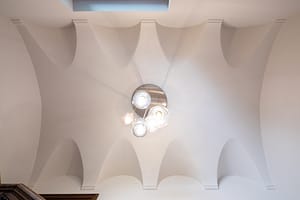'recovering a moment of modern regionalism '
From a stylistic point of view, the villa reflects the taste of the era and the professional preoccupations of the architect who designed it: a tempered modernism of Balkan and Classicist regional accents. Developed in a large volume with a basement, ground floor, two upper floors and an attic, proves a series of impressive architecturally spatial and constructive qualities for the modernist-regionalist stylistic direction to which it belongs. We note the balanced aesthetics of the white facades in contrast to the wooden elements of the balcony cantilever beams and handrails, the smooth sloping roof covered with eaves, the well-proportioned partition of the interior spaces, the generosity of the living room separated from the dining room by sliding doors camouflaged in the thickness of the wall, the arrival moment of the inner staircase on the first floor, the cross vaults ceiling area, the massive wooden beams of the ceiling and the composite pier caps at the pillars in the living room, the metalworking with seamless grids, the woodwork with joints without nails.
'architectural qualities and degradations'
The door-windows providing access to the garden has been preserved with difficulty over the postwar decades. They were turned into smaller windows with parapets and added heaters, although the living room floor was provided with access grilles for hot air ducts that came from the underground facility – a remarkable technical aspect at the time. The wooden parapet from the upper balcony was completely degraded, the original window frameworks suffered much, the plaster fell from many parietal areas on the outside and inside, and the living room was diminished with a partition wall during the communist occupation.


The rehabilitation of the internal stair handrails was complemented by the integral recovery of the parquet after its dismounting from the ground floor and the upper floors. Remounting it in the attic floor gave an original character to the generous space of the former garret. Here, the satisfactory height did not require major structural changes: removing only a few wooden pillars of the roof allowed the new furniture positioning. There were also added attic windows and a family relaxation space with multimedia equipment and a minibar. The natural stone has replaced the old faience of the bathrooms, and the original sliding doors on the ground floor have been completely rehabilitated.
'restoration and remodelling'
The Studio3plus office has restored the ground floor to its original shape, the second floor being transformed into a secondary living area with a kitchen, living room and guest bedrooms. The parasitic interior partitions – those that doubled the original hall – were removed and the bedrooms, after enlargement, also received their own bathrooms. The cooking space, which is very important for the current villa owners, has expanded in relation to the two separate day zones on the ground floor and on the second floor. Just like in the interwar period, the underground spaces now host the servants and permanent cooks of the house.
- Location Bucharest, Romania
- Area 1106.45m²
- Photography Radu Malașincu
- Date null
- Exterior profile SCHUCO
- Furniture Baxter, Cattelan, Smania, Twils, Antonio Lupi, Gessi, Oasis Group
- Light Deltalight, Serip, Catellani&Smith, Arturo Alvares, Petridis























